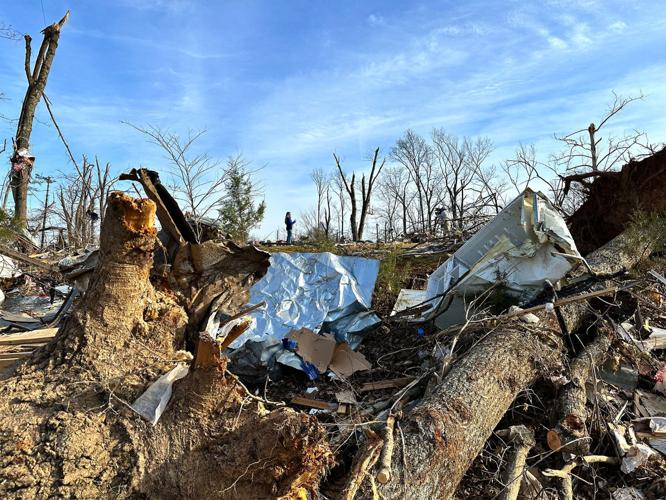
Heather Mathis covering the 2023 tornado
Street View is a monthly column taking a close look at development-related issues affecting different neighborhoods throughout the city.
Heather Mathis moved to Nashville in 2017 to become a meteorologist for NewsChannel 5. Since then, she’s covered tornadoes, floods, heat waves and cold fronts. During severe weather, viewers have often contacted her to ask about safe places to shelter. Initially, there weren’t many options. “That led me to do years of stories about it, everything from building codes to the lack of storm shelters because of liability laws.”
Nashville has historically faced two main problems in terms of storm shelter availability. First, organizations worried about liability when they opened their doors to the public — building insurance often wouldn’t cover sheltering people during severe weather. Second, there wasn’t a good source of public information about available shelters when severe weather occurred.
To solve the liability issue, Mathis worked with state Rep. Jason Powell (D-Nashville) to pass HB1080. Passed in April of last year, the new law dictates that any organization that provides shelter during severe weather will no longer be liable for loss, damages, injury or death.
Now that HB1080 has passed, Mathis is working on making an easy-to-access list of available shelters. On March 3, NC5 will release an interactive list of Safe Places on its website, which will show which buildings are open in real time. The Metro Council is also participating in the process, with a goal to add one shelter per district when the list goes live. During severe-weather events, NC5 will broadcast open shelters live on air.
Mathis says organizations like Hands On Nashville, Nashville VOAD (a coalition of organizations helping people respond to disasters), the Metro government and emergency management offices across Tennessee have reached out to take part in the program.
Nashville has a significant need for shelters during tornadoes, floods and extreme cold-weather events. As recently reported by the Scene’s Eli Motycka, this year’s severe winter weather tested the city’s shelter network. Motycka spoke with organizations providing shelter to people living outside, in cars or other temporary spots — a group of people who Metro’s Point-in-Time Count estimates increased 11 percent from 2022 to 2023. Amid freezing temperatures, Metro opened two overflow shelters in January, offering refuge to hundreds of Nashvillians.

Heather Mathis covering the 2023 tornado
Nashville’s rapid development has made the city vulnerable to flooding; global climate change is making severe-weather events more frequent than ever; and the city has an affordable housing crisis, pushing many people into substandard housing or housing insecurity. These factors mean many people need easily accessible public emergency shelters.
Craig Croskery, a meteorologist whose doctoral research project findyourtornadoshelter.com maps public tornado shelters across the U.S., says programs like Safe Places are crucial for getting the word out about available shelters.
“Many people live in substandard housing or in mobile homes, and those cannot withstand any tornado safely, as we saw in December in Nashville,” Croskery says. “Private storm shelters have become popular, but many people can’t afford them — especially those already vulnerable. Ensuring people have a safe place and those are publicized can greatly help save lives during severe weather and especially during tornadoes.”
People experiencing homelessness are particularly at risk during severe weather. Lower-income people are also vulnerable, says Croskery, since “they often live in mobile homes or weaker structures that cannot withstand a significant tornado (or, in many cases, any tornado).”
“There are far more of [these structures] in more rural areas as well as in lower-income parts of cities like Nashville, and those likely have higher proportion of residents who are Black or Hispanic,” he says. Nationwide, the long-term effects of racist housing policy mean Black people have higher risks of experiencing negative effects from tornadoes and hurricanes.
For District 22 Councilmember Sheri Weiner, the Safe Places program is an important step to save lives.
“When I think back to the floods in 2010 I remember our scrambling for locations for neighbors in affected areas to seek shelter as well as making sure their pets were able to go along or be cared for,” Weiner says. “I am reminded of this every time we have weather events that wreak havoc on homes and people’s lives.”
“What Heather has created will offer folks an opportunity to seek safe shelter closer than what is currently available,” she says. “The more spaces that become available, the more lives we will save.”
In December, the Metro Council honored Mathis for her work on the program. She tells the Scene that having shelters available will also make her job easier. “As meteorologists, our highest calling is to save lives and walk people through those scary moments,” Mathis says. “It’s really hard when people are in that vulnerable place to say, ‘We just don’t have those kind of shelters around.’ It really drove me to continue to focus on the shelters that we need here.”
Going forward, Mathis aims to get Safe Places lists to more counties across Tennessee. Eleven counties, including Davidson, have added shelters to the list so far, and Mathis hopes Safe Places could become a statewide program. “I just want this program to continue to grow and for us to have a very, very long list for people to be able to seek shelter if needed.”




